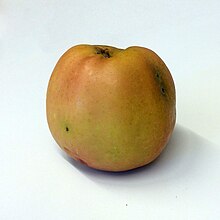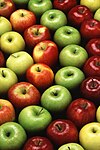
The persimmon is the edible fruit of a number of species of trees in the genus Diospyros. The most widely cultivated of these is the Oriental persimmon, Diospyros kaki. Diospyros is in the family Ebenaceae, and a number of non-persimmon species of the genus are grown for ebony timber. In 2019, China produced 75% of the world total of persimmons.

The tangelo, Citrus × tangelo, is a citrus fruit hybrid of a Citrus reticulata variety, such as a mandarin orange or tangerine, and a Citrus maxima variety, such as a pomelo or grapefruit. The name is a portmanteau of 'tangerine' and 'pomelo'.
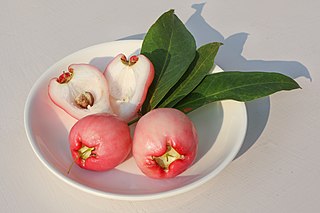
Syzygium samarangense is a species of flowering plant in the family Myrtaceae, native to an area that includes the Greater Sunda Islands, Malay Peninsula and the Andaman and Nicobar Islands, but introduced in prehistoric times to a wider area and now widely cultivated in the tropics. Common names in English include wax apple, Java apple, Semarang rose-apple and wax jambu. It is very common in the Southern Indian state of Kerala, where it is known as chambakka.

The Haralson is a cultivar of apple that is medium-sized and has a round-conic shape.

The Braeburn is a cultivar of apple that is firm to the touch with a red/orange vertical streaky appearance on a yellow/green background. Its color intensity varies with different growing conditions.

The 'Pink Pearl' apple is a pink-fleshed apple cultivar developed in 1944 by Albert Etter, a northern California breeder. It is a seedling of 'Surprise', another pink-fleshed apple that is believed to be a descendant of Malus niedzwetskyana.

Ginger Gold is a yellow apple variety which entered commerce in the 1980s, though the original seedling dates from the late 1960s. According to the US Apple Association website it is one of the fifteen most popular apple cultivars in the United States.
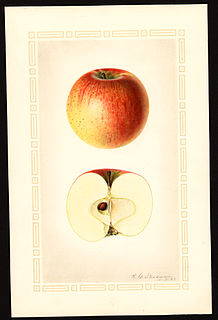
The origins of the Rambo apple cultivar are unknown. It may date back to the American colony of New Sweden, when in 1637 Peter Gunnarsson Rambo, a Swedish immigrant, arrived on the Kalmar Nyckel. Swedish natural historian Pehr Kalm, who wrote Travels in North America, 1747–51, took notes of his interview with Mr. Peter Rambo, grandson of Peter Gunnarsson Rambo, recording that the ″original Peter Rambo had brought apple seeds and several other tree and garden seeds with him in a box.″ The first Rambo apple tree was very likely grown from one of these seeds. There is no certainty, however, since the earliest documented mention of the apple variety's origin occurs in William Coxe's A View of the Cultivation of Fruit Trees, and the Management of Orchards and Cider, published in 1817. Coxe wrote only that the Rambo was much cultivated in Delaware, Pennsylvania, and New Jersey and took "its name from the families by whom it was introduced into notice."

An apple is an edible fruit produced by an apple tree. Apple trees are cultivated worldwide and are the most widely grown species in the genus Malus. The tree originated in Central Asia, where its wild ancestor, Malus sieversii, is still found today. Apples have been grown for thousands of years in Asia and Europe and were brought to North America by European colonists. Apples have religious and mythological significance in many cultures, including Norse, Greek, and European Christian tradition.

The Blue Java is a hardy, cold-tolerant banana cultivar known for its sweet aromatic fruit, which is said to have an ice cream-like consistency and flavor reminiscent of vanilla.

Liberty is a hybrid apple cultivar developed by the New York State Agricultural Experiment Station. It was a seedling produced in 1955 from pollinating 'Macoun' from 'Purdue 54-12' for the sake of acquiring Malus floribunda disease resistances. It was first released to the public in 1978.

White Transparent is an early-season cultivar of apple which is usually used for cooking due to its sharp taste. It is sometimes said to be the same as 'Yellow Transparent', but 'Yellow Transparent' is sometimes described differently, with fine rather than coarse flesh, and a sub-acid rather than acid flavour.

'Surprise' is a pink-fleshed apple that is the ancestor of many of the present-day pink/red-fleshed apples bred by American growers.

Manks Codlin is an early cultivar selected from the domesticated apple that were growing at Isle of Man. It has many other names, including 'Winter Saint Lawrence' and 'Eva'. It first fruited in 1815. This cultivar is considered particularly cold hardy and well suited to exposed sites and poor soils.

'Akane' also known as 'Tokyo Rose', 'Tohoku No.3' and 'Prime Red' is a Japanese cultivar of domesticated apple, that according to Orange Pippin is one of the best early season apples.

'Alkmene' is a German cultivar of domesticated apple, also called 'Early Windsor'.
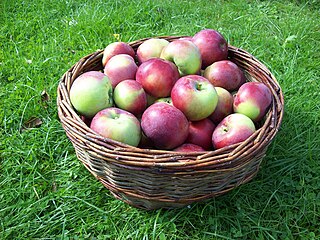
'Birgit Bonnier' is a modern cultivar of domesticated apple which have some resistance to apple scab and mildew.

Lady Alice is a cultivar of domesticated apple which was discovered in 1979 at an orchard near Gleed, Washington, as a chance seedling and is a registered trademark by the Rainier Fruit Company. It is named after Alice Zirkle, a co-founder of the company.

Gascoyne's Scarlet is an English cultivar of domesticated apple which is used to produce apple juice with a pink color. Is named after its developer, Mr. Gascoyne of Bapchild near Sittingbourne, Kent, England, who bred it before 1871.
